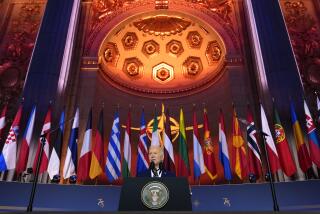PERSPECTIVE ON NATO : Keep a Close Eye on Russia
- Share via
Contrary to assertions by numerous defense experts, the quandary confronting NATO’s leaders today is not how to change its strategic orientation and thus avoid a continued drift into obsolescence. It is the underlying conflict between seeing Russia as a potential security partner or a security threat. Unfortunately, imprudently, the former is what the Clinton Administration envisions with the accommodationist policy it is bringing to this week’s NATO summit: Invite the new East European democracies to join a “partnership for peace” that will neither offend Moscow nor answer their security worries. In fact, denying full NATO support to the most vulnerable of the former Soviet satellites is more likely to encourage Russia’s re-emerging imperial tendencies.
Recent developments in Russia ought to reinforce the heretofore minority view among Western analysts that NATO’s traditional missions--deterrence, defense and reassurance against a potential threat from the East--are as valid as ever.
The problems festering in Russia are not simply economic, amenable to “reform” of the Yeltsin program and an infusion of Western aid. The popular discontent and its manifestations remind many of Weimar Germany in the early 1930s: an authoritarian and imperialistic populace that has become impatient with economic privation, cynical about its government at all levels, disoriented by tumultuous political change and, with the exception of a small stratum of intellectuals, rather uninspired by democratic ideals. In short, a populace ready for a radical leader to rise up and set things right.
While everybody is focusing on the size of Vladimir Zhirinovsky’s following--and it is troubling--nobody seems bothered by other menacing signs from Russia itself: Moscow has asserted a “Monroe doctrine” in Eastern Europe and the former Soviet Union and enunciated an aggressive general military doctrine; it has failed to withdraw troops from the Baltics; it has been trying to destabilize Ukraine, and in such areas as Moldova, Georgia and Azerbaijan its forces have been both provoking conflicts and fighting therein.
All of this should give pause to those who cannot see the fine line between encouraging democracy in Russia and placating Moscow. It is strategically myopic to try to ensure Western security by perpetuating a security vacuum in Eastern Europe. In fact, keeping such countries as Poland out of NATO invites precisely the problem the West is trying to avoid: encouraging Russia to meddle in Eastern European affairs.
Instead of the vague multilateralism of the Clinton Administration’s “partnership for peace,” which seems to treat all Central and East European countries as equally worthy candidates for a security guarantee, NATO’s best course now is to offer membership at least to Poland, Hungary and the Czech Republic. It is specious to argue that such an extension of NATO’s boundaries eastward would push Russia onto an anti-Western course. To believe that is to put far too much stock in Zhirinovsky’s imperialist bluster. As Henry Kissinger has aptly noted, “We resisted blackmail when Russia was strong. Does it make sense to permit Moscow to blackmail us now with its domestic weakness?”
Enlarging NATO’s membership need not be provocative. It does not have to include full partnership in NATO’s unified military structure, although NATO’s forward defense guarantee should extend to the new members. It is the political and strategic symbolism that is important.
The primary threat to security in the East is not a Russian military invasion of Ukraine or Poland. Rather, if the Russian empire is to be re-established it will be through a combination of economic pressure and subversion, abetted by the target states’ sense of being abandoned by the West.
Clearly, NATO’s most important function in the years ahead is a combination of deterrence and reassurance. A new cordon sanitaire in the East would cause no ascertainable harm and would be immensely valuable if Russia were to show signs of preferring its old ways to the hard work of institutionalizing democracy.
Of course, tinkering with NATO membership is not enough. We also need to arrest the decline in NATO’s military capabilities and particularly to stop the erosion of its nuclear component. Given the post-Cold War geopolitical changes and the precipitous decline of Russia’s conventional military capabilities, NATO can afford to get rid of all short-range and battlefield nuclear systems. Arguably, for the foreseeable future, NATO’s nuclear assets need not do more than prevent nuclear intimidation by Russia (or some unforeseen other power), a task that can be performed by a relatively small force of nuclear-armed aircraft, augmented by a modest theater-ballistic missile defense capability. For the time being, the quality of NATO’s statecraft and the fact of its cohesion are the most important guarantors of Euorpean security.
Still, even these modest goals for NATO are not easy tasks in a time of economic belt-tightening, uncertain political leadership and public distaste for a muscular foreign policy. They will be made particularly difficult by timid arguments for accommodating Moscow at all costs, and by the widening gulf in European and American thinking about Western security issues. The alternatives, however, are quite bleak. It would be ironic in the extreme if, while the Soviet Union lost the Cold War, NATO were to lose the post-Cold War peace.
More to Read
Sign up for Essential California
The most important California stories and recommendations in your inbox every morning.
You may occasionally receive promotional content from the Los Angeles Times.










